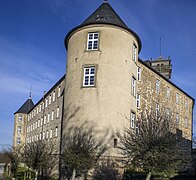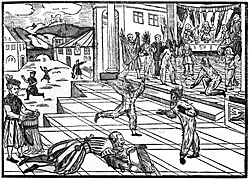Waldenburg Castle (Hohenlohe)

Waldenburg Castle is located on the outskirts of the town of Waldenburg on a mountain spur that rises above the Hohenlohe plain . The building, partly designed as a renaissance castle , is owned by the Hohenlohe-Waldenburg-Schillingsfürst family .
history
The Waldenburg region became a fiefdom of the Hohenlohe family around 1250 . A castle was first mentioned in a document in 1253. The city rights were conferred for 1330 Waldenburg. It was converted into a castle in the 16th century, with parts of the changes being reversed in the 18th century. The main seat of one of the Hohenlohe lines was the building in 1553. The keep , also known as the Männlesturm , was given its present form in 1576. In the early 17th century, further structural changes were carried out for which Heinrich Schickhardt acted as a consultant. The castle stood empty from 1679, because the Hohenlohe-Waldenburg line died out. The St. Michael Castle Church was built by master plasterer Christian Dornacher in 1781 and 1782. In the 19th century, the castle was comprehensively renovated through a new line from Hohenlohe-Waldenburg that was created through the division of inheritance . The castle, like almost 80 percent of the entire city area, fell victim to the flames in 1945 by artillery fire. The reconstruction took place from 1948 to 1963.
Hans Gottfried von Stockhausen (born May 12, 1920 at Trendelburg; † January 8, 2010 in Remshalden-Buoch) was a German glass painter, painter and draftsman. He was best known for his more than 500 church windows and architecture-related works at home and abroad. Von Stockhausen maintained his studio at Waldenburg Castle, where he often showed exhibitions of his works to the public.
Waldenburg Carnival
On February 7, 1570, Count Eberhard von Hohenlohe-Waldenburg and his wife, Countess Agathe von Tübingen , invited noble friends and relatives, including the countess's brother, Georg III. von Tübingen , the nephews Count Albrecht von Hohenlohe-Neuenstein, Valentin von Berlichingen, Kunz von Vellberg and Simon von Neudeck. Possibly inspired by local customs, the idea of disguising oneself had occurred even though a state order had been passed three years earlier that prohibited carnival: women disguised themselves as angels and men as devils. A fire broke out at the festival caused by a costume that caught fire. Several visitors were killed as a result of this accident and many were seriously injured. Court preacher Apin describes what happened in an authentic contemporary report:
- “In 1570, February 7th, things went badly in Waldenburg; An unfortunate case has arisen, there the wretched Satan has caused terrible tragedies and spectaculence from God's disaster, and as an angry glee, chilled his mother for pleasure: therefore one should not paint him over the door, nor invite him to be a guest, because he comes probably by himself, or wherever he doesn’t get there himself, he sends his messengers there.
- At that time in Waldenburg during Carnival, next to the counts and next to those of Adel there were nine countesses, some of whom wore a beautiful English habit, so they went in very white clothes with white paper wings, as they are used to paint angels, and wore white paper crowns on their heads, in which little wax lights burned and shone: on the other hand the gentlemen and the nobility disguised themselves with a hideous habit, had thick tow of flax sewn on and knotted on their trousers and doublets, arms and legs, that they came in shaggy and ragged, as one tends to paint the cacodaemones and black hellhounds.
- By kneeling in the upper hall by the light, and not being careful with the light, after having held a dance at night at 10 o'clock in the upper hall, and not being careful with the light, the burning gout suddenly comes to the fore: soon there will be a crowd in the hall Great commotion and crowd, great shock, screams and complaints: Kunz von Vellberg soon gives up the escape, and so hooded he jumps in the snails so that he gets away unharmed and is not infected by the others, but Veltlin von Berlichingen and Simon von Neudeck and Count Albert von Hohenlohe (Neuenstein) burn so hard that they have to lie in bed for several weeks. Count Georg von Tübingen received the evening meal on February 22nd.
- After that (on March 5th), Sunday was Latare (since a different and new coincidence suddenly struck him as a fire), dies at 8 a.m. and is then buried on the 7th hujus with his husband's great suffering, pain and lamentation to Oehringen in the collegiate church, because I then gave him a funeral sermon, which I afterwards sent his wife mother to Lichteneck on her request on May 22nd with my GH light sermon, on the other hand, your grace gave me the following on July 24th through von Bubenhofen to be handed over: a silver cup with a lid, on which the Tübingen coat of arms has been engraved. My gn. Lord, Count Eberhard, burned so hard that afterwards, after February 21st and 22nd, all of his fingers had to be cut off in front of both hands, after all, on the 29th (that was Sunday Reminiscere at the time), he had received the Reverend Communion, and actually did one beautiful Christian acquaintance, which I had a particular pleasure in. After the 9th Marti, four days after his brother-in-law Count Georgen said goodbye, dies in the Frauenzimmerstuben at 10 o'clock in the morning in my presence, the 11th day hujus zu Oehringen is buried in the collegiate church next to his wife mother and next to Count Georgen Christian memory since I then gave him a sermon. Count Albrecht took the 14th Marti back home to Neuenstein, and with the advice and help of his wife mother came back up. "
Veltin von Berlichingen and Simon von Neudeck died in the fire, as well as Counts Albert von Hohenlohe, Eberhard von Waldenburg and Georg von Tübingen.
buildings
The outside of the castle was rebuilt as far as possible according to its historical appearance. Parts of the building are in the Renaissance style, while the castle church already contains classical elements. The interiors were no longer true to the original, but rebuilt in a simplified manner.
Seal Museum
A seal museum has been set up on the ground floor of the castle since 1972. The collection goes back to the 19th century and was founded by Prince Karl zu Hohenlohe-Waldenburg. He is considered one of the founding fathers of Sphragistics . The seals on display are reproductions, some of which are already very old.
gallery
literature
- Ulrich Feldhahn: Castle Tour Baden-Württemberg . Michael Imhof Verlag, Petersberg 2005, ISBN 3-935590-63-6 .
Individual evidence
- ↑ Pushkin at Waldenburg Castle ( Memento of the original from May 15, 2016 in the Internet Archive ) Info: The archive link was inserted automatically and has not yet been checked. Please check the original and archive link according to the instructions and then remove this notice. , on Hohenloher Tageblatt , November 5, 2010; accessed on May 15, 2016.
- ^ The fire carnival of 1570 (Waldenburg).
- ↑ Five nobles burned at the Mummery. (PDF; 3.2 MB)
Web links
Coordinates: 49 ° 11 ′ 27.7 " N , 9 ° 38 ′ 34.7" E









